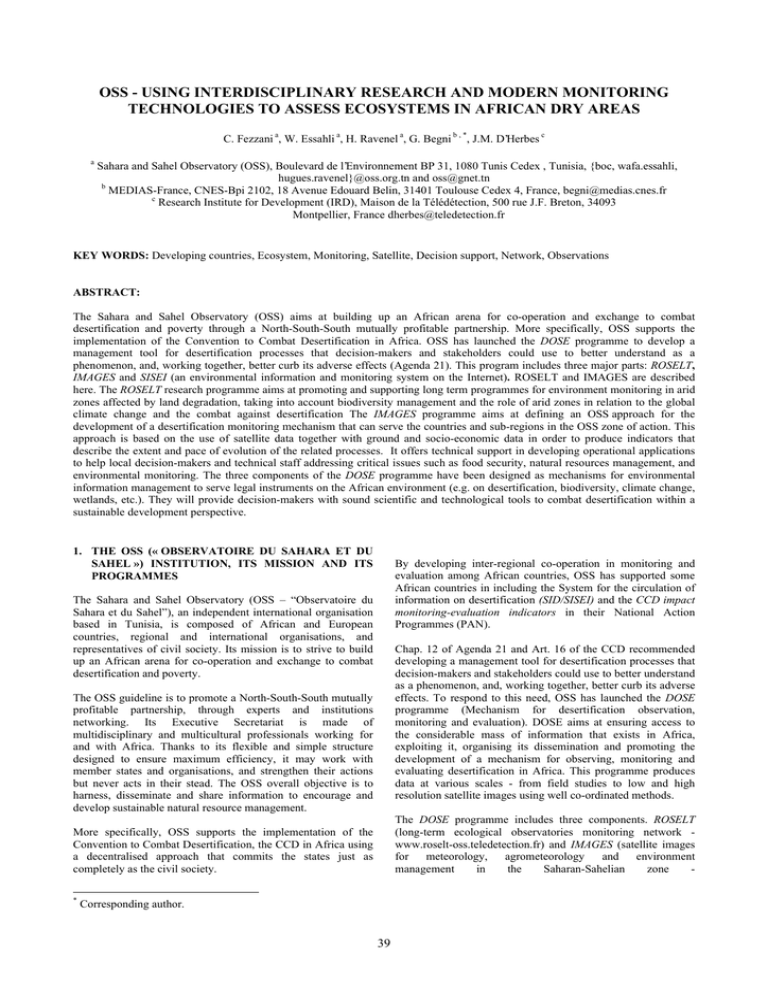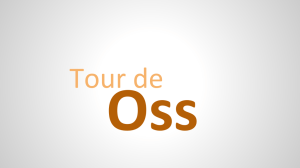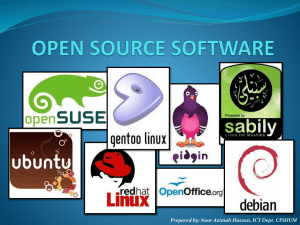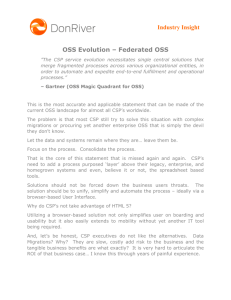OSS - USING INTERDISCIPLINARY RESEARCH AND MODERN MONITORING
advertisement

OSS - USING INTERDISCIPLINARY RESEARCH AND MODERN MONITORING
TECHNOLOGIES TO ASSESS ECOSYSTEMS IN AFRICAN DRY AREAS
C. Fezzani a, W. Essahli a, H. Ravenel a, G. Begni b , *, J.M. D’Herbes c
a
Sahara and Sahel Observatory (OSS), Boulevard de l’Environnement BP 31, 1080 Tunis Cedex , Tunisia, {boc, wafa.essahli,
hugues.ravenel}@oss.org.tn and oss@gnet.tn
b
MEDIAS-France, CNES-Bpi 2102, 18 Avenue Edouard Belin, 31401 Toulouse Cedex 4, France, begni@medias.cnes.fr
c
Research Institute for Development (IRD), Maison de la Télédétection, 500 rue J.F. Breton, 34093
Montpellier, France dherbes@teledetection.fr
KEY WORDS: Developing countries, Ecosystem, Monitoring, Satellite, Decision support, Network, Observations
ABSTRACT:
The Sahara and Sahel Observatory (OSS) aims at building up an African arena for co-operation and exchange to combat
desertification and poverty through a North-South-South mutually profitable partnership. More specifically, OSS supports the
implementation of the Convention to Combat Desertification in Africa. OSS has launched the DOSE programme to develop a
management tool for desertification processes that decision-makers and stakeholders could use to better understand as a
phenomenon, and, working together, better curb its adverse effects (Agenda 21). This program includes three major parts: ROSELT,
IMAGES and SISEI (an environmental information and monitoring system on the Internet). ROSELT and IMAGES are described
here. The ROSELT research programme aims at promoting and supporting long term programmes for environment monitoring in arid
zones affected by land degradation, taking into account biodiversity management and the role of arid zones in relation to the global
climate change and the combat against desertification The IMAGES programme aims at defining an OSS approach for the
development of a desertification monitoring mechanism that can serve the countries and sub-regions in the OSS zone of action. This
approach is based on the use of satellite data together with ground and socio-economic data in order to produce indicators that
describe the extent and pace of evolution of the related processes. It offers technical support in developing operational applications
to help local decision-makers and technical staff addressing critical issues such as food security, natural resources management, and
environmental monitoring. The three components of the DOSE programme have been designed as mechanisms for environmental
information management to serve legal instruments on the African environment (e.g. on desertification, biodiversity, climate change,
wetlands, etc.). They will provide decision-makers with sound scientific and technological tools to combat desertification within a
sustainable development perspective.
1. THE OSS (« OBSERVATOIRE DU SAHARA ET DU
SAHEL ») INSTITUTION, ITS MISSION AND ITS
PROGRAMMES
By developing inter-regional co-operation in monitoring and
evaluation among African countries, OSS has supported some
African countries in including the System for the circulation of
information on desertification (SID/SISEI) and the CCD impact
monitoring-evaluation indicators in their National Action
Programmes (PAN).
The Sahara and Sahel Observatory (OSS – “Observatoire du
Sahara et du Sahel”), an independent international organisation
based in Tunisia, is composed of African and European
countries, regional and international organisations, and
representatives of civil society. Its mission is to strive to build
up an African arena for co-operation and exchange to combat
desertification and poverty.
Chap. 12 of Agenda 21 and Art. 16 of the CCD recommended
developing a management tool for desertification processes that
decision-makers and stakeholders could use to better understand
as a phenomenon, and, working together, better curb its adverse
effects. To respond to this need, OSS has launched the DOSE
programme (Mechanism for desertification observation,
monitoring and evaluation). DOSE aims at ensuring access to
the considerable mass of information that exists in Africa,
exploiting it, organising its dissemination and promoting the
development of a mechanism for observing, monitoring and
evaluating desertification in Africa. This programme produces
data at various scales - from field studies to low and high
resolution satellite images using well co-ordinated methods.
The OSS guideline is to promote a North-South-South mutually
profitable partnership, through experts and institutions
networking. Its Executive Secretariat is made of
multidisciplinary and multicultural professionals working for
and with Africa. Thanks to its flexible and simple structure
designed to ensure maximum efficiency, it may work with
member states and organisations, and strengthen their actions
but never acts in their stead. The OSS overall objective is to
harness, disseminate and share information to encourage and
develop sustainable natural resource management.
The DOSE programme includes three components. ROSELT
(long-term ecological observatories monitoring network www.roselt-oss.teledetection.fr) and IMAGES (satellite images
for
meteorology,
agrometeorology
and
environment
management
in
the
Saharan-Sahelian
zone
-
More specifically, OSS supports the implementation of the
Convention to Combat Desertification, the CCD in Africa using
a decentralised approach that commits the states just as
completely as the civil society.
*
Corresponding author.
39
The International Archives of the Photogrammetry, Remote Sensing and Spatial Information Sciences, Vol. XXXIV, Part 6/W6
•
www.unesco.org/oss/v_fr/programmes), serve to improve
regional-level knowledge on the desertification process. They
plan to enable African and European scientific institutions to
develop methodologies for co-observation of environmental
inter-observatory measurements either on the ground or using
satellite images. SISEI is an environmental information and
monitoring system on the Internet, aiming at helping to circulate
information scattered in many centres of expertise
(www.sisei.net). The two first components, ROSELT and
DOSE, are described hereunder.
•
identify methods and techniques for environmental
rehabilitation and rational management of natural
resources;
provide reliable information on the scope of desertification
and its ecological, agro-ecological and socio-economic
consequences.
A unique feature for ROSELT is that, for first time, African
countries have committed themselves to joining forces to
develop a common cross-border monitoring tool for the circumSaharan area as a whole (OSS region) by merging their national,
sub-regional and regional interests.
The objective of the Network for Long Term Ecological
Monitoring Observatories (ROSELT) Programme is to promote
and support long term programmes for environment monitoring
in arid zones affected by land degradation.
3. THE IMAGES PROGRAMME
The IMAGES programme objective is to provide the various
African data processing centres in the OSS area with
standardised tools and methods for exploiting low resolution
satellite images acquired using instruments such as
NOAA/AVHRR and Spot 4-5/VEGETATION.
The main objective of the IMAGES programme is to provide
the various African data processing centres in the OSS area with
standardised tools and methods for exploiting low resolution
satellite images acquired using instruments such as
NOAA/AVHRR and Spot 4-5/VEGETATION. This
programme offers technical support in developing operational
applications that involve products derived from low resolution
images to help local decision-makers and technical staff with
critical issues such as food security, natural resources
management, and environmental monitoring.
ROSELT and IMAGES aim at providing the OSS partners with a
sound scientific and technological basis to address ecosystem
assessment in dry areas using advanced interdisciplinary
research and modern monitoring tools.
The IMAGES programme has three main components:
2. THE ROSELT PROGRAMME
•
As stated above, the Network for Long Term Ecological
Monitoring Observatories (ROSELT) Programme is to promote
and support long term programmes for environment monitoring
in arid zones affected by land degradation. Biodiversity
management and the role of arid zones in relation to the global
climate change and the combat against desertification are taken
into proper account. ROSELT is developed by IRD (“Institut de
Recherche pour le Développement”), a French institute, and
INSAH, an African regional institute linked to CILSS (« Centre
Inter-Etats pour la Lutte contre la Sècheresse au Sahel »).
•
•
3.1 Component A: SPACE II/OSS software
In order to strengthen exchange relations in the OSS zone, the
SPACE II/OSS software was developed to provide for standard
operational processing of AVHRR images acquired by
NOAA/HRPT receiving stations. It has been adapted for
production purposes and is tailored to rapidly generate
optimally corrected mosaics by incorporating calibration,
atmospheric correction, navigation, automated correlation using
ground control points, and restitution of given cartographic
projection.
After an initial stage of design and start-up, involving the
countries concerned and a group of North and South experts,
ROSELT is currently implementing a quadrennial programme
on a group of pilot observatories where data collection and
processing protocols are being applied and tested. These
protocols were produced using harmonised methods, and
defined and validated products such as biophysical and socioeconomic indicators. The participating observatories constitute
a network of territories representing the main ecological
situations in the area where research programmes in line with
sustainable development are being carried out. Up to now,
ROSELT has been considered as the tool and the scientific
framework for desertification surveillance and monitoringevaluation mechanisms needed for the Action Programmes
defined by the CCD.
The core of the software was developed and validated by
JRC/SAI (Joint Research Centre/Space Applications Institute)
of the European Commission. It is run on Unix workstation
under Solaris 2.5 and offers user-friendly interface with
multiple windows, pull-down menus and click-and-point tasks.
Several African centres are equipped with SPACE II/OSS, and
OSS will consider requests for it from all African centres in the
OSS zone. Furthermore, a PC version and an adaptation to
process data from the VEGETATION instrument are available
The ROSELT network was designed to:
•
•
•
component A: consolidation, monitoring and evolution of
SPACE II/OSS software;
component B: study of a desertification monitoring
mechanism;
component C: pilot project of AVHRR data process by
SPACE II/OSS
3.2 Component B: study of a desertification monitoring
mechanism
provide reliable, harmonised data bases for the preparation
of "states of the environment" at different levels;
better understand ill functioning of the ecological systems
and the mechanics of desertification;
assess the impact of developmental actions and actions to
combat desertification;
Thought and discussion by OSS and its partners are part of the
implementation of environmental planning instruments
provided for in the CCD (NAP, SRAP, RAP). The aim is to
define an OSS approach for the development of a desertification
monitoring mechanism that can serve the countries and subregions in the OSS zone of action. This approach is based on the
40
The International Archives of the Photogrammetry, Remote Sensing and Spatial Information Sciences, Vol. XXXIV, Part 6/W6
use of satellite data together with ground and socio-economic
data in order to produce indicators that describe the extent and
pace of evolution of the processes in question.
•
The Desertification Monitoring Mechanism thus defined forms
an integrated set of information systems connected to the
existing territorial level of activity and responsibility. It abides
by the principle of subsidiarity with each level carrying out
actions for which it is best-equipped, bearing in mind the
requirements of sustainable development. Each of the systems
produces indicators and information products based on both
biophysical and socio-economic multi-scale, multi-source and
multi-date geographical data and strives to satisfy the needs of
the main categories of users, viz. scientists, experts, decisionmakers, representatives of the civil society.
•
In more tangible terms, the mechanism will depend on the
establishment of "situation centres" and "analytical centres",
probably at the state level, and "co-ordination centres" at the
sub-regional level, and "information centres" at the regional or
international level. This work will be organised in three stages:
•
•
•
can be used for a more accurate analysis and a better
description of the spatio-temporal evolution of vegetation.
These indexes also provide information on biomass and
main crop yield.
Bush fires: Reflectance measurements from bands 3, 4 and
5 of the AVHRR sensor allow for quite good detection of
active fires both in daytime and at night. This information
can be delivered quickly to local users.
Water balance: Surface temperature (computed from
AVHRR bands 4 and 5) is a good pointer for vegetation
cover evapotranspiration, which has bearing on water
balance estimation. Comparing surface temperature with
albedo (calculated from AVHRR bands 1 and 2) makes it
possible to produce an indicator of vegetation desiccation.
This information can be used in early warning systems for
agrometeorology, agroforestry and plant physiology.
4. CONCLUSIONS
The DOSE programme brings together ROSELT, a scientific
component aiming at better understanding what are the leading
desertification processes and monitoring them through available
information, and IMAGES, an application-oriented programme
aiming at setting up operational monitoring systems. An active
synergy between these two aspects is quite mandatory to set up
robust monitoring actions as defined in the UNCCD and in the
related National Action Plans. Such an effort has been made
possible through North-South scientific and technological cooperation, taking advantage of ground knowledge available at
local, national and regional scales, modern observation systems
and associated software developments, federative research in
European and African laboratories. The SID/SISEI concept
allows a better information circulation and a flexible access to
widely spread sources. This should make the DOSE programme
a success story for African countries in implementing the
UNCCD, such combating the impacts of dryness and
desertification and consolidating their way to a sustainable
development in spite of the many natural and socio-economic
challenges they have to face.
establishment of a preliminary desertification monitoring
mechanism to produce simplified but immediately useable
indicators (institutional and technical stage);
consolidation of simplified indicators and preparation of
more sophisticated indicators (essentially scientific stage);
gradual transformation of preliminary mechanism into a
stronger mechanism that uses the upgraded indicators
prepared in phase 2 (technical stage).
The creation of this mechanism will require the development of
a strong, balanced partnership between the African and nonAfrican organisations working on food security or
environmental warning systems in order to strengthen the
African capacity for analyses and decision-making.
These technical and scientific stages of the project will require
substantial funding to which OSS will contribute. This
mechanism fits in completely with the conclusions of a
workshop on desertification warning systems convened by the
CCD Secretariat in Niamey in October 1999.The workshop
conclusions were approved by the Conference of Parties in
Recife that same year. Much thought has been given
internationally to this theme and several initiatives are being
considered to materialise mechanisms of this sort. By actively
participating in this work, OSS contributes to harmonising
various approaches and calling appropriate attention to the
achievements of its member states and organisations.
ADDITIONAL INFORMATION SOURCES
OSS, 1997. Stratégie 2000 de l’OSS. General Assembly,
Niamey, February.
OSS, 2002. http://www2.unesco.org/oss1/ (accessed 4th March
2002).
In a first step and at the national level, the mechanism will be
developed in Algeria, Morocco and Tunisia under EC funding
(LIFE-Third Countries).
OSS, SCOT, 1999. Etude d’un système global de suivi de la
désertification intégrant données satellitaires et mesures terrain.
December.
3.3 Component C: Applications of SPACE II/OSS
OSS, UNITAR, 2000. Guide SISEI, Systèmes de Circulation de
l'Information et de Suivi de l'Environnement sur Internet. Edited
by OSS, UNITAR, GTZ and Ministère Français des Affaires
Etrangères, January.
Thanks to the products provided by SPACE II/OSS software,
the following applications can be investigated from the local to
the regional level using well-controlled technical and scientific
bases. They have been tested together with the “Centre de Suivi
Ecologique" (CSE, Dakar, Senegal), and AGRHYMET (a
CILSS centre, West Africa) and as part of a capacity-building
programme on early warning and food security for the IGAD
region:
•
ROSELT/OSS, 1997. Présentation générale de ROSELT,
ROSELT leaflet, April.
ROSELT/OSS, 2002. Organisation, Méthodologie et
Fonctionnement du Réseau ROSELT/OSS, January. See also
http://www.roselt-oss.teledetection.fr/ (accessed 4th March
2002).
Monitoring natural vegetation and crops: Improved
vegetation indexes derived from SPACE II/OSS software
41




